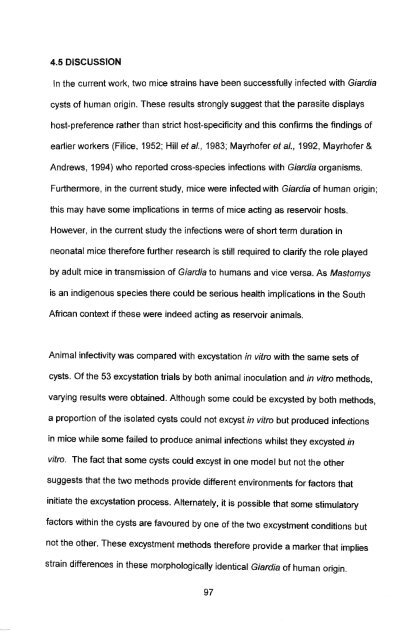in vitro culture and isoenzyme analysis of giardia lamblia
in vitro culture and isoenzyme analysis of giardia lamblia
in vitro culture and isoenzyme analysis of giardia lamblia
Create successful ePaper yourself
Turn your PDF publications into a flip-book with our unique Google optimized e-Paper software.
4.5 DISCUSSION<br />
In the current work, two mice stra<strong>in</strong>s have been successfully <strong>in</strong>fected with Giardia<br />
cysts <strong>of</strong> human orig<strong>in</strong>. These results strongly suggest that the parasite displays<br />
host-preference rather than strict host-specificity <strong>and</strong> this confirms the f<strong>in</strong>d<strong>in</strong>gs <strong>of</strong><br />
earlier workers (Filice, 1952; Hill et al., 1983; Mayrh<strong>of</strong>er et al., 1992, Mayrh<strong>of</strong>er &<br />
Andrews, 1994) who reported cross-species <strong>in</strong>fections with Giardia organisms.<br />
Furthermore, <strong>in</strong> the current study, mice were <strong>in</strong>fected with Giardia <strong>of</strong> human orig<strong>in</strong>;<br />
this may have some implications <strong>in</strong> terms <strong>of</strong> mice act<strong>in</strong>g as reservoir hosts.<br />
However, <strong>in</strong> the current study the <strong>in</strong>fections were <strong>of</strong> short term duration <strong>in</strong><br />
neonatal mice therefore further research is still required to clarify the role played<br />
by adult mice <strong>in</strong> transmission <strong>of</strong> Giardia to humans <strong>and</strong> vice versa. As Mastomys<br />
is an <strong>in</strong>digenous species there could be serious health implications <strong>in</strong> the South<br />
African context if these were <strong>in</strong>deed act<strong>in</strong>g as reservoir animals.<br />
Animal <strong>in</strong>fectivity was compared with excystation <strong>in</strong> <strong>vitro</strong> with the same sets <strong>of</strong><br />
cysts. Of the 53 excystation trials by both animal <strong>in</strong>oculation <strong>and</strong> <strong>in</strong> <strong>vitro</strong> methods,<br />
vary<strong>in</strong>g results were obta<strong>in</strong>ed. Although some could be excysted by both methods,<br />
a proportion <strong>of</strong> the isolated cysts could not excyst <strong>in</strong> <strong>vitro</strong> but produced <strong>in</strong>fections<br />
<strong>in</strong> mice while some failed to produce animal <strong>in</strong>fections whilst they excysted <strong>in</strong><br />
<strong>vitro</strong>. The fact that some cysts could excyst <strong>in</strong> one model but not the other<br />
suggests that the two methods provide different environments for factors that<br />
<strong>in</strong>itiate the excystation process. Alternately, it is possible that some stimulatory<br />
factors with<strong>in</strong> the cysts are favoured by one <strong>of</strong> the two excystment conditions but<br />
not the other. These excystment methods therefore provide a marker that implies<br />
stra<strong>in</strong> differences <strong>in</strong> these morphologically identical Giardia <strong>of</strong> human orig<strong>in</strong>.<br />
97
















